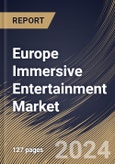The Europe Immersive Entertainment Market would witness market growth of 22.9% CAGR during the forecast period (2023-2030).
The rise of location-based entertainment (LBE), where immersive technologies are used to create unique experiences in physical venues like theme parks and entertainment centers, is anticipated to boost market growth. LBE has been influential in expanding the market by offering consumers innovative and interactive experiences beyond the conventional home environment, which is expected to drive market development over the forecast period.
VR has grown in popularity, transforming how users consume content and interact with virtual environments. The development of high-quality VR headsets and the proliferation of VR content across various industries, from gaming to education, has propelled this technology into the mainstream. As hardware becomes more available and affordable, the VR trend is set to continue its upward trajectory. AR has found applications in gaming, marketing, and everyday experiences. The success of AR-powered mobile apps like Pokémon Go has demonstrated the mass appeal of this technology. As AR hardware evolves and becomes more sophisticated, its integration into this form of entertainment experiences is expected to diversify.
According to the UK government's Office for National Statistics, people's median disposable income reached £32,300. In contrast to a longer-term gain of 1.7% per year over the ten years preceding 2022 (FYE 2013 to FYE 2022), the median household disposable income climbed by an average of 0.7% per year between FYE 2020 and FYE 2022. Rising disposable income contributes to the success of subscription-based models for premium immersive content. Consumers may subscribe to premium VR content services, unlocking exclusive, high-quality experiences. Due to the aforementioned factors the market growth will drive in this region.
The Germany market dominated the Europe Immersive Entertainment Market, by Country in 2022, and would continue to be a dominant market till 2030; thereby, achieving a market value of $25,219.6 Million by 2030. The UK market is exhibiting a CAGR of 21.7% during (2023 - 2030). Additionally, The France market would experience a CAGR of 23.8% during (2023 - 2030).
Based on Technology, the market is segmented into Virtual Reality (VR), Augmented Reality (AR), Mixed Reality (MR) and Others. Based on Application, the market is segmented into Gaming, Music & Concerts, Immersive Theater, Arcade Studios, Live Events, Sports, Museum & Cultural Experiences and Others. Based on countries, the market is segmented into Germany, UK, France, Russia, Spain, Italy, and Rest of Europe.
The rise of location-based entertainment (LBE), where immersive technologies are used to create unique experiences in physical venues like theme parks and entertainment centers, is anticipated to boost market growth. LBE has been influential in expanding the market by offering consumers innovative and interactive experiences beyond the conventional home environment, which is expected to drive market development over the forecast period.
VR has grown in popularity, transforming how users consume content and interact with virtual environments. The development of high-quality VR headsets and the proliferation of VR content across various industries, from gaming to education, has propelled this technology into the mainstream. As hardware becomes more available and affordable, the VR trend is set to continue its upward trajectory. AR has found applications in gaming, marketing, and everyday experiences. The success of AR-powered mobile apps like Pokémon Go has demonstrated the mass appeal of this technology. As AR hardware evolves and becomes more sophisticated, its integration into this form of entertainment experiences is expected to diversify.
According to the UK government's Office for National Statistics, people's median disposable income reached £32,300. In contrast to a longer-term gain of 1.7% per year over the ten years preceding 2022 (FYE 2013 to FYE 2022), the median household disposable income climbed by an average of 0.7% per year between FYE 2020 and FYE 2022. Rising disposable income contributes to the success of subscription-based models for premium immersive content. Consumers may subscribe to premium VR content services, unlocking exclusive, high-quality experiences. Due to the aforementioned factors the market growth will drive in this region.
The Germany market dominated the Europe Immersive Entertainment Market, by Country in 2022, and would continue to be a dominant market till 2030; thereby, achieving a market value of $25,219.6 Million by 2030. The UK market is exhibiting a CAGR of 21.7% during (2023 - 2030). Additionally, The France market would experience a CAGR of 23.8% during (2023 - 2030).
Based on Technology, the market is segmented into Virtual Reality (VR), Augmented Reality (AR), Mixed Reality (MR) and Others. Based on Application, the market is segmented into Gaming, Music & Concerts, Immersive Theater, Arcade Studios, Live Events, Sports, Museum & Cultural Experiences and Others. Based on countries, the market is segmented into Germany, UK, France, Russia, Spain, Italy, and Rest of Europe.
List of Key Companies Profiled
- Meta Platforms, Inc. (Meta)
- Microsoft Corporation
- HTC Corporation
- Barco NV
- Magic Leap, Inc.
- Samsung Electronics Co., Ltd. (Samsung Group)
- Apple, Inc.
- Sony Corporation
- Qualcomm Incorporated (Qualcomm Technologies, Inc.)
- Unity Software, Inc.
Market Report Segmentation
By Technology- Virtual Reality (VR)
- Augmented Reality (AR)
- Mixed Reality (MR)
- Others
- Gaming
- Music & Concerts
- Immersive Theater
- Arcade Studios
- Live Events
- Sports
- Museum & Cultural Experiences
- Others
- Germany
- UK
- France
- Russia
- Spain
- Italy
- Rest of Europe
Table of Contents
Chapter 1. Market Scope & Methodology
Chapter 2. Market at a Glance
Chapter 3. Market Overview
Chapter 4. Competition Analysis - Global
Chapter 5. Europe Immersive Entertainment Market, by Technology
Chapter 6. Europe Immersive Entertainment Market, by Application
Chapter 7. Europe Immersive Entertainment Market, by Country
Chapter 8. Company Profiles
Companies Mentioned
- Meta Platforms, Inc. (Meta)
- Microsoft Corporation
- HTC Corporation
- Barco NV
- Magic Leap, Inc.
- Samsung Electronics Co., Ltd. (Samsung Group)
- Apple, Inc.
- Sony Corporation
- Qualcomm Incorporated (Qualcomm Technologies, Inc.)
- Unity Software, Inc.
Methodology

LOADING...








